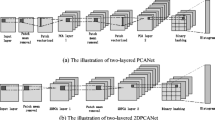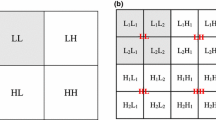Abstract
Nowadays, image recognition has become a highly active research topic in cognitive computation community, due to its many potential applications. Generally, the image recognition task involves two subtasks: image representation and image classification. Most feature extraction approaches for image representation developed so far regard independent component analysis (ICA) as one of the essential means. However, ICA has been hampered by its extremely expensive computational cost in real-time implementation. To address this problem, a fast cognitive computational scheme for image recognition is presented in this paper, which combines ICA and the extreme learning machine (ELM) algorithm. It tries to solve the image recognition problem at a much faster speed by using ELM not only in image classification but also in feature extraction for image representation. As an example, our proposed approach is applied to the face image recognition with detailed analysis. Firstly, common feature hypothesis is introduced to extract the common visual features from universal images by the traditional ICA model in the offline recognition process, and then ELM is used to simulate ICA for the purpose of facial feature extraction in the online recognition process. Lastly, the resulting independent feature representation of the face images extracted by ELM rather than ICA will be fed into the ELM classifier, which is composed of numerous single hidden layer feed-forward networks. Experimental results on Yale face database and MNIST digit database have shown the good performance of our proposed approach, which could be comparable to the state-of-the-art techniques at a much faster speed.



















Similar content being viewed by others
Notes
Throughout this paper, the superscript in X′ denotes the transpose of X.
The database can be downloaded from http://cvc.yale.edu/projects/yalefaces/yalefaces.html.
The database can be downloaded from http://yann.lecun.com/exdb/mnist/.
The image sets can be downloaded from http://www.cad.zju.edu.cn/home/dengcai/Data/FaceData.html.
The Matlab codes can be downloaded from http://www.ifp.illinois.edu/~jyang29/ScSPM.htm.
The Matlab codes can be downloaded from http://www.cis.hut.fi/projects/tsp/index.php?page=OPELM.
The image sets can be downloaded from http://www.cad.zju.edu.cn/home/dengcai/Data/FaceData.html.
The image sets can be downloaded from http://www1.ustb.edu.cn/resb/en/index.htm.
The image sets can be downloaded from http://www.cad.zju.edu.cn/home/dengcai/Data/MLData.html.
References
Taylor JG. Cognitive computation. Cogn Comput. 2009;1(1):4–16.
Cambria E, Hussain A. Sentic Computing: Techniques, Tools, and Applications. Springer Briefs in Cogn Comput. Dordrecht, Netherlands: Springer 2012.
Wang QF, Cambria E, Liu CL, Hussain A. Common sense knowledge for handwritten Chinese recognition. Cogn Comput. 2013;5(2):234–42.
Rakover SŚ, Cahlon B. Face recognition: cognitive and computational processes. Amsterdam: John Benjamins; 2001.
Jain AK, Duin RPW, Mao J. Statistical pattern recognition: a review. IEEE Trans Pattern Anal. 2000;22:4–37.
Zhao W, Chellappa R, Phillips PJ, Rosenfeld A. Face recognition: a literature survey. ACM Comput Surv. 2003;35:399–458.
Yambor WS. Analysis of PCA-based and Fisher discriminant-based image recognition algorithms. Master Thesis, Colorado State University, 2000.
Shakhnarovich G, Moghaddam B. Face recognition in subspaces. In handbook of face recognition. New York: Springer; 2011.
Wang X, Tang X. A unified framework for subspace face recognition. IEEE Trans Pattern Anal. 2004;26:1222–8.
Vasilescu MAO, Terzopoulos D. Multilinear subspace analysis of image ensembles. In: 2003 IEEE Computer Society Conference on Computer Vision and Pattern Recognition. 2003, p. II-93–99.
Brunelli R, Poggio T. Face recognition: features versus templates. IEEE Trans Pattern Anal. 1993;15:1042–52.
Liu C, Wechsler H. Gabor feature based classification using the enhanced fisher linear discriminant model for face recognition. IEEE Trans Image Process. 2002;1:467–76.
Hjelmås E. Feature-based face recognition. In: Proceedings norwegian image processing and pattern recognition conference, 2000.
Jutten C, Herault J. Blind separation of sources, part I: an adaptive algorithm based on neuromimetic architecture. Signal Process. 1991;24:1–10.
Comon P. Independent component analysis, a new concept. Signal Process. 1994;36:287–314.
Te-Won L. Independent component analysis, theory and applications. Boston: Kluwer Academic; 1998.
Hyvärinen A, Oja E. Independent component analysis: algorithms and applications. Neural Netw. 2000;13:411–30.
Jolliffe IT. Principal component analysis. New York: Springer; 2002.
Shlens J. A tutorial on principal component analysis. In: Technical report, systems neurobiology laboratory, University of California at San Diego; 2005.
Zou H, Hastie T, Tibshirani R. Sparse principal component analysis. J Comput Graph Stat. 2006;15:265–86.
Huang GB, Zhu QY, Siew CK. Extreme learning machine: theory and applications. Neurocomputing. 2006;70:489–501.
Huang GB, Wang DH, Lan Y. Extreme learning machines: a survey. Int J Mach Learn Cybern. 2011;2:107–22.
Huang GB, Zhu QY, Siew CK. Extreme learning machine: a new learning scheme of feed forward neural networks. In: Proc. Int. Joint Conf. Neural Netw. (IJCNN2004), Budapest, Hungary; 2004: 985–990.
Huang GB, Chen L, Siew CK. Universal approximation using incremental constructive feed forward networks with random hidden nodes. IEEE Trans Neural Netw. 2006;17(4):879–92.
Huang GB, Chen L. Convex incremental extreme learning machine. Neurocomputing. 2007;70:3056–62.
Huang GB, Chen L. Enhanced random search based incremental extreme learning machine. Neurocomputing. 2008;71:3460–8.
Huang GB, Zhou H, Ding X, Zhang R. Extreme learning machine for regression and multiclass classification. IEEE Trans Syst Man Cybern. 2012;42(2):513–29.
Huang GB, Li MB, Chen L, Siew CK. Incremental extreme learning machine with fully complex hidden nodes. Neurocomputing. 2008;71:576–83.
Liang NY, Huang GB, Saratchandran P, Sundararajan N. A fast and accurate online sequential learning algorithm for feed forward networks. IEEE Trans Neural Netw. 2006;17(6):1411–23.
Miche Y, Sorjamaa A, Bas P, Simula O, Jutten C, Lendasse A. OP-ELM: optimally pruned extreme learning machine. IEEE Trans Neural Netw. 2010;21(1):158–62.
Zhao Z, Liu B, Li W. Image classification based on extreme learning machine. IEIT J Adapt Dynam Comput. 2012;1:5–11.
Zhao J, Zhou Z, Cao F. Human face recognition based on ensemble of polyharmonic extreme learning machine. Neural Comput Appl. 2013. doi:10.1007/s00521-013-1356-4.
Marques I, Graña M. Face recognition with lattice independent component analysis and extreme learning machines. Soft Comput. 2012;16:1525–37.
Olshausen BA. Emergence of simple-cell receptive field properties by learning a sparse code for natural images. Nature. 1996;381:607–9.
Field DJ. What is the goal of sensory coding? Neural Comput. 1994;6:559–601.
Bartlett MS. Face image analysis by unsupervised learning. Dordrecht: Kluwer Academic; 2001.
Bartlett MS, Movellan JR, Sejnowski TJ. Face recognition by independent component analysis. IEEE Trans Neural Netw. 2002;13:1450–64.
Barlow HB. Unsupervised learning. Neural Comput. 1989;1:295–311.
Hyvärinen A, Oja E. A fast fixed-point algorithm for independent component analysis. Neural Comput. 1997;9:1483–92.
Hansen LK, Salamon P. Neural network ensemble. IEEE Trans Pattern Anal Mach Intell. 1990;12(10):993–1001.
Cai D, He X, Hu Y, Han J, Huang T. Learning a spatially smooth subspace for face recognition. In: IEEE Conference on Computer Vision and Pattern Recognition (CVPR); 2007: 1–7.
Mankiewicz R. The story of mathematics. Princeton: Princeton Univ. Press; 2004.
Chow SL. Statistical significance: rationale, validity and utility. London, UK: Sage; 1996.
Acknowledgments
This work is partially supported by the High Technology Research and Development Program of China (2006AA09Z231), Natural Science Foundation of China (41176076, 31202036, 51075377), and the Science and Technology Development Program of Shandong Province (2008GG1055011, BS2009HZ006).
Author information
Authors and Affiliations
Corresponding author
Rights and permissions
About this article
Cite this article
Zhang, S., He, B., Nian, R. et al. Fast Image Recognition Based on Independent Component Analysis and Extreme Learning Machine. Cogn Comput 6, 405–422 (2014). https://doi.org/10.1007/s12559-014-9245-4
Received:
Accepted:
Published:
Issue Date:
DOI: https://doi.org/10.1007/s12559-014-9245-4




